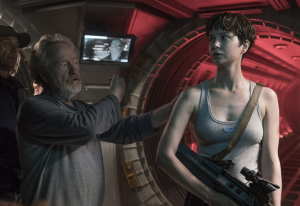
The debut volume of Green Lantern: Earth One evoked an enthusiastic response from superhero readers, providing a hard sci-fi sheen to the familiar, colorful adventures of one Harold Jordan. It was only in the third act that the first volume pivoted into the superhero genre, slowly excavating a few familiar elements of Green Lantern lore like the Manhunters, a long guardian, and some familiar allies like Kilowog. This is the mode of storytelling that the sequel is engaged in from start to finish—rushing through new information, characters, and superpowered encounters in a fashion that makes it read more like a collection of Rebirth issues than the accessible graphic novel it is presented to be. It’s an unfortunate decline from the standards developed at the project’s start, and one that leaves readers to wander more about what could have been in these pages than what is actually present.
Videos by ComicBook.com
Volume Two opens three years after the “Battle of Earth,” and humanity is preparing to make a cultural exchange with alien Llaran people. There are multiple organizations involved, including the barely discussed Centcom—a global force with its eye on space and authoritarian tendencies. This story provides plenty of hooks for reader interest, but none of these avenues are ever explored in a satisfying fashion. This introduction is a gateway to a much larger story featuring yellow lanterns, rebellious Corps members (including Sinestro), and multiple human missions gone awry. The resulting plots reads like a Where’s Waldo of Green Lantern lore as more and more elements are introduced, rarely being given enough space to define themselves for any reader not already looking to spot existing names and concepts. Sinestro serves as a prime example (as does another familiar earthbound GL from comics); his name informs readers far better about his motivations and character than anything on the page.
The pacing of this volume is breathless with so many elements to introduce and plot threads to weave together. After the initial encounter with the Llarans goes wrong, Jordan is quickly swept into an ongoing conflict between the revived Green Lantern Corps and a mysterious new group of Yellow Lanterns, with outfits and auras that often read as orange. While the two events are inevitably connected, as each new piece of the puzzle is provided there’s never sufficient space to consider the threats or their implications. As a result characters are often left to deliver exposition directly to their comrades (and readers). The plot reads like an outline for a film or longer series in development; readers receive all of the highlights, but the essential work of developing characters, relationships, and underlying themes are drowned out by the rush to this story’s finish line.
While there’s enough embedded in this plot to maintain the attention of the curious or existing Green Lantern fans looking for something slightly different, it’s difficult to say much about these events when the story concludes. It is a largely hollow vessel. There is one brief moment that defies this pacing and suggests what could have been when Jordan encounters an alien race eating crystals exposed in an asteroid belt. There is wonder and invention present here, suggesting the infinite forms of life to be found in the cosmos. It’s the first and last moment of genuine awe in a comic filled with explosive battles and (unnecessary) explanations of a multiverse.
Beyond the drama of multi-colored lanterns, there are multiple story threads focused on unpowered humans and they provide artist Gabriel Hardman with ample opportunity to provide the gritty, sci-fi aesthetics that defined both the first volume and his prior collaboration with writer (and partner) Corrina Bechko as well as colorist Jordan Boyd, Invisible Republic. It’s still an irresistible take on space as humanity may one day know it. Interstellar ships, spacesuits, and the rest all feel real in an inviting fashion that contrasts well against the glowing forms of Green Lanterns. Even as the story moves past explaining Earth’s rapid acceleration in spacefaring technology or their impacts on culture or individuals, there’s plenty to explore within the panels that suggest a mythology behind the rapidfire events of this comic. The strongest connective tissue between volumes of Green Lantern: Earth One is their aesthetic, and it remains a compelling element here.
It’s this aesthetic that suggests the promise of Green Lantern: Earth One remains, even in the wake of a disappointing sophomore element. After a patient introduction to this reimagined lore, there’s a rush to include as many new ideas here and it reads like an abridged adaptation of multiple story ideas. Yet the awed approach to both astronomy and biology, as well as a diverse collection of human and alien characters, all suggest there are still great stories to be told here. In the wake of Volume Two, there’s an opportunity to slow down and refocus the series on what works best: the exploration and understanding of concepts that belie the sci-fi concept of Green Lantern. It’s unfortunate the pacing and events of an increased focus on the superhero genre eclipses that promise in these pages.
Rating: 3 out of 5
Published by DC Comics
On August 11, 2020
Written by Corrina Bechko and Gabriel Hardman
Art by Gabriel Hardman
Colors by Jordan Boyd
Letters by Simon Bowland
Cover by Gabriel Hardman and Jordan Boyd








